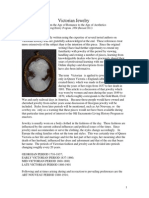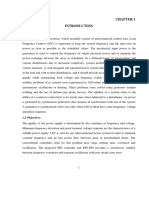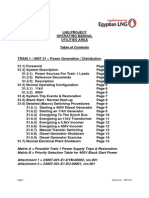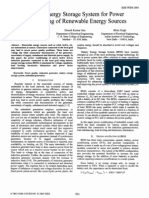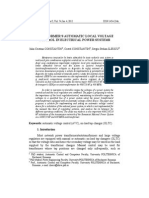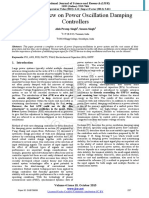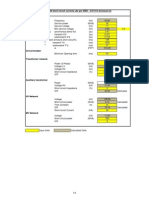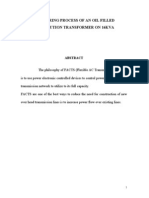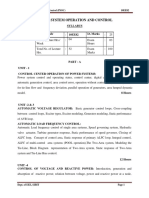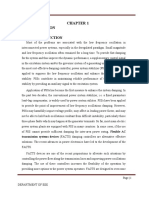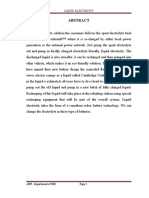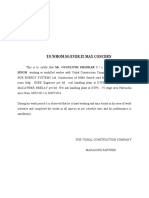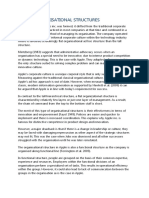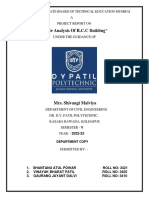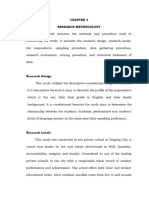Study of Reactive Power Compensation
Study of Reactive Power Compensation
Uploaded by
praneethCopyright:
Available Formats
Study of Reactive Power Compensation
Study of Reactive Power Compensation
Uploaded by
praneethCopyright
Available Formats
Share this document
Did you find this document useful?
Is this content inappropriate?
Copyright:
Available Formats
Study of Reactive Power Compensation
Study of Reactive Power Compensation
Uploaded by
praneethCopyright:
Available Formats
Reactive Power Compensation
REACTIVE POWER COMPENSATION
ABSTRACT:
The quality of electrical power in a network is a major concern which has to be examined with
caution in order to achieve a reliable electrical power system network. Reactive power
compensation is a means for realising the goal of a qualitative and reliable electrical power
system. This paper made a comparative review of reactive power compensation technologies; the
devices reviewed include Synchronous Condenser, Static Var Compensator (SVC) and Static
Synchronous Compensator (STATCOM). These technologies were defined, critically examined
and compared, the most promising technology is recommended for the realisation of an effective,
efficient, sustainable, qualitative and reliable electrical power network
Investment is necessary for the studies into the security and stability of the power
grid, as well as the improved control schemes of the transmission system. Different
approaches such as reactive power compensation and phase shifting have been applied to increase
the stability and the security of the power systems. The demands of lower power losses, faster
response to system parameter change, and higher stability of system have stimulated the
development of the Flexible AC Transmission systems (FACTS). Based on the success of
research in power electronics switching devices and advanced control technology, FACTS has
become the technology of choice in voltage control, reactive/active power flow control,
transient and steady-state stabilization that improves the operation and functionality of existing
power transmission and distribution system
ABIT, Department of EEE Page 1
Reactive Power Compensation
1. INTRODUCTION:
The demand of the reactive power is mainly originated from inductive load
connected to the system . These inductive loads generally electromagnetic
circuit of electric motors, electrical transformers, distribution networks and
induction furnaces etc. Reactive power compensation is the defined as the
management of reactive power to improve the performance of AC system .
There are two aspects : - 1. Load compensation 2. Voltage support
During the past two decades, the increase in electrical energy demand has
presented higher requirements from the power industry. More power plants, substations, and
transmission lines need to be constructed. However, the most commonly used devices in
present power grid are the mechanically-controlled circuit breakers. The long switching
periods and discrete operation make them difficult to handle the frequently changed loads
smoothly and damp out the transient oscillations quickly. In order to compensate these
drawbacks, large operational margins and redundancies are maintained to protect the system
from dynamic variation and recover from faults. This not only increases the cost and lowers
the efficiency, but also increases the complexity of the system and augments the difficulty of
operation and control. Severe black-outs happened recently in power grids worldwide and
these have revealed that conventional transmission systems are unable to manage the control
requirements of the complicated interconnections and variable power flow.
Therefore, investment is necessary for the studies into the security and stability of the power
grid, as well as the improved control schemes of the transmission system. Different
approaches such as reactive power compensation and phase shifting have been applied to
increase the stability and the security of the power systems. The demands of lower power
losses, faster response to system parameter change, and higher stability of system have
stimulated the development of the Flexible AC Transmission systems (FACTS) [1]. Based
on the success of research in power electronics switching devices
ABIT, Department of EEE Page 2
Reactive Power Compensation
2. BASIC PRINCIPAL OF POWER COMPENSATION IN TRANSMISSION
SYSTEM:
Figure 1.1(a) shows the simplified model of a power transmission system. Two power
grids are connected by a transmission line which is assumed lossless and represented by the
reactance XL. V1∠δ1 and V2 ∠δ 2 represent the voltage phasors of the two power grid buses with
angle δ= δ1- δ2 between the two. The corresponding phasor diagram is shown in Figure 1.1(b).
Figure 1. Power transmission system: (a) simplified model; (b) phase diagram
3. REACTIVE POWER:
Reactive power is the power that supplies the stored energy in reactive elements. Power, as
we know, consists of two components, active and reactive power. The total sum of active and
reactive power is called as apparent power. In AC circuits, energy is stored temporarily in
inductive and capacitive elements, which results in the periodic reversal of the direction of
flow of energy between the source and the load. The average power after the completion of
one whole cycle of the AC waveform is the
real power, and this is the usable energy of the system and is used to do work, whereas the
portion of power flow which is temporarily stored in the form of magnetic or electric fields
and flows back and forth in the transmission line due to inductive and capacitive network
elements is
known as reactive power. This is the unused power which the system has to incur in order to
transmit power.
ABIT, Department of EEE Page 3
Reactive Power Compensation
Inductors (reactors) are said to store or absorb reactive power, because they store energy in
the form of a magnetic field. Therefore, when a voltage is initially applied across a coil, a
magnetic field builds up, and the current reaches the full value after a certain period of time.
This in turn causes the current to lag the voltage in phase.
Capacitors are said to generate reactive power, because they store energy in the form of an
electric field. Therefore when current passes through the capacitor, a charge is built up to
produce the full voltage difference over a certain period of time. Thus in an AC network the
voltage across the capacitor is always charging. Since, the capacitor tends to oppose this
change;
it causes the voltage to lag behind current in phase.
In an inductive circuit, we know the instantaneous power to be:
ABIT, Department of EEE Page 4
Reactive Power Compensation
4. Flexible AC Transmission System (FACTS):
The history of FACTS controllers can be traced back to 1970s when Hingorani
presented the idea of power electronic applications in power system compensation. From then
on, various researches were conducted on the application of high power semiconductors in
transmission systems. The shunt-connected Static VAR compensator (SVC) using solid- state
switches and the series-connected controllers were proposed in AC transmission system
application. In 1988, Hingorani defined the FACTS concept and described the wide prospects
of the application in. Nowadays, FACTS technology has shown strong potential. Many
examples of FACTS devices and controllers are in operation
As presented, FACTS and FACTS controllers are defined in IEEE Terms and
Definitions as:
• Flexible AC Transmission System (FACTS): Alternating current transmission systems
incorporating power electronic-based and other static controllers to enhance controllability
and increase power transfer capability.
• FACTS Controller: A power electronic-based system and other static equipment that provide
control of one or more AC transmission system parameters.
As new technology for power transmission system, FACTS and FACTS controllers not only
provide the same benefits as conventional compensators with mechanically- controlled
switches in steady state but also improve the dynamic and transient performance of the power
system. The power electronics-based switches in the functional blocks of FACTS can usually
be operated repeatedly and the switching time is a portion of a periodic cycle, which is much
shorter than the conventional mechanical switches. The advance of semiconductors increases
the switching frequency and voltage-ampere ratings of the solid switches and facilitates the
applications. For example, the switching frequencies of Insulated Gate Bipolar Transistors
(IGBTs) are from 3 kHz to 10 kHz which is several hundred times the utility frequency of
power system (50~60Hz). Gate turn-off thyristors (GTOs) have a switching frequency lower
than 1 kHz, but the voltage and current rating can reach 5-8 kV and 6 kA respectively [8].
FACTS controllers have many configurations. In general, they can be categorized into shunt-
connected controllers, series-connected controllers and their combinations.
ABIT, Department of EEE Page 5
Reactive Power Compensation
5.SHUNT-CONNECTED CONTROLLERS:
FACTS controllers can be impedance type, based on thyristors without gate turn-off
capability, which are called Static Var Compensator (SVC) for shunt-connected application.
Another type of FACTS controllers is converter-based which is usually in the form of a Static
Synchronous Compensator (STATCOM).
5.1 Static Var Compensator (Svc)
Static Var Compensator is “a shunt-connected static Var generator or absorber whose output
is adjusted to exchange capacitive or inductive current so as to maintain or control specific
parameters of the electrical power system (typically bus voltage)” [5].
SVC is based on thyristors without gate turn-off capability. The operating principal and
characteristics of thyristors realize SVC variable reactive impedance. SVC includes two main
components and their combination:
(1) Thyristor-controlled and Thyristor-switched Reactor (TCR and TSR); and
(2) Thyristor-switched capacitor (TSC). In Figure 1.4 shows the diagram of SVC.
Figure 2. Static VAR Compensators (SVC): TCR/TSR, TSC, FC and Mechanically Switched
Resistor
TCR and TSR are both composed of a shunt-connected reactor controlled by two parallel,
reverse-connected thyristors. TCR is controlled with proper firing angle input to operate in a
ABIT, Department of EEE Page 6
Reactive Power Compensation
continuous manner, while TSR is controlled without firing angle control which results in a
step change in reactance.
TSC shares similar composition and same operational mode as TSR, but the reactor is
replaced by a capacitor. The reactance can only be either fully connected or fully
disconnected zero due to the characteristic of capacitor.
With different combinations of TCR/TSR, TSC and fixed capacitors, a SVC can meet various
requirements to absorb/supply reactive power from/to the transmission line.
5.2 CONVERTER-BASED COMPENSATOR
Static Synchronous Compensator (STATCOM) is one of the key Converter-based
Compensators which are usually based on the voltage source inverter (VSI) or current source
inverter (CSI), Unlike SVC, STATCOM controls the output current independently of the AC
system voltage, while the DC side voltage is automatically maintained to serve as a voltage
source. Mostly, STATCOM is designed based on the VSI.
Figure 3. STATCOM topologies: (a) STATCOM based on VSI and CSI (b) STATCOM with
storage
Compared with SVC, the topology of a STATCOM is more complicated. The switching
device of a VSI is usually a gate turn-off device paralleled by a reverse diode; this function
ABIT, Department of EEE Page 7
Reactive Power Compensation
endows the VSI advanced controllability. Various combinations of the switching devices and
appropriate topology make it possible for a STATCOM to vary the AC output voltage in both
magnitude and phase. Also, the combination of STATCOM with a different storage device or
power source endows the STATCOM the ability to control the real power output.
STATCOM has much better dynamic performance than conventional reactive power
compensators like SVC. The gate turn-off ability shortens the dynamic response time from
several utility period cycles to a portion of a period cycle. STATCOM is also much faster in
improving the transient response than a SVC. This advantage also brings higher reliability and
larger operating range.
STATCOM is a very popular FACTS controller application effective in transmission system
voltage control. Since 1980 when the first STATCOM (rated at 20 Mvar) using force-
commutated thyristor inverters was put into operation in Japan [10], many examples have
been installed and the ratings have been increased considerably. In 1991, KEPCO and
Mitsubishi Motors installed a ±80MVar STATCOM at Inuyama Switching Station [11]. In
1996, TVA, EPRI and Westinghouse installed a ±100MVar STATCOM at Sullivan 500 kV
Substation [12]. In 2001, EPRI and Siemens developed a ±200MVar STATCOM at Marcy
345kV substation . It is expected that more STATCOMs will be installed due to the advances
in technology and commercial success.
STATCOM could have many topologies, but in most practical applications it employs the DC
to AC converter, which can also be called a Voltage Source Inverter (VSI) in 3-phase
configuration as the primary block. The basic theory of VSI is to produce a set of controllable
3-phase output voltages/ currents at the fundamental frequency of the ACbus voltage from a
DC input voltage source such as a charged capacitor or a DC energy supply device. By
varying the magnitude and phase angle of the output voltage and current, the system can
exchange active/reactive power between the DC and AC buses, and regulate the AC bus
voltage.
ABIT, Department of EEE Page 8
Reactive Power Compensation
6 POWER TRIANGLES
Active Power ( P )
Reactive Power ( Q )
Apparent Power ( S )
Active Power ( P )
It is the power that actually powers the equipment and performs useful
work . Unit of it W .
Reactive Power ( Q ) : -
It is the power that magnetic equipment { transformer , motor etc. }
needs to produce the magnetizing flux . Unit of it VAr .
Apparent Power ( S ) : -
It is the “ vectorial summation ” of active power ( P ) and reactive power
( Q ) . Unit of it VA .
SYNCHRONOUS CONDENSER
Synchronous condensers are the active shunt compensators and have been used to
improve the voltage profile and system stability .
It is installed at the receiving end of the line
ABIT, Department of EEE Page 9
Reactive Power Compensation
When machine is overexcited , it acts as shunt capacitor as it supplies VAr to the
system and when under excited it acts as a shunt coil as it absorbs reactive power to
maintain terminal voltage.
Compensation Techniques
1).Synchronous Condenser
2). Shunt Compensation
3) Series Compensation
ABIT, Department of EEE Page 10
Reactive Power Compensation
6 Series Compensation: -
Capacitor are connected in series in the lines and are used mainly for boosting the
receiving end voltage, increase in transmission capacity and reduction in losses in the lines .
The capacitive reactance of series capacitor neutralizes the inductive reactance of the line
hence , reduces effective reactance of the line. Thereby , voltage regulation of the system is
improved .
Shunt Compensation: -
ABIT, Department of EEE Page 11
Reactive Power Compensation
The device that is connected in parallel with the transmission line for reactive power
compensation is called the shunt compensator It can be provided by either a current source,
voltage source or a capacitor. If XC = 1/ωC be the reactance of the shunt capacitor then the
reactive power generated of leading VAr supplied by the capacitor: Where, |V2| is the
magnitude of receiving end voltage.
7. NEED FOR REACTIVE POWER COMPENSATION:
The main reason for reactive power compensation in a system is: 1) the voltage
regulation; 2) increased system stability; 3) better utilization of machines connected to the
system; 4) reducing losses associated with the system; and 5) to prevent voltage collapse as
well as voltage sag. The impedance of transmission lines and the need for lagging VAR by
most machines in a generating system results in the consumption of reactive power, thus
affecting the stability limits of the system as well as transmission lines. Unnecessary voltage
drops lead to increased losses which needs to be supplied by the source and in turn leading to
outages in the line due to increased stress on the system to carry this imaginary power. Thus
we can infer that the compensation of reactive power not only mitigates all these effects but
also helps in better transient response to faults and disturbances. In recent times there has
been an increased focus on the techniques used for the compensation and with better devices
included in the technology, the compensation is made more effective. It is very much required
ABIT, Department of EEE Page 12
Reactive Power Compensation
that the lines be relieved of the obligation to carry the reactive power, which is better provided
near the generators or the loads. Shunt compensation can be installed near the load, in a
distribution substation or transmission substation.
ADVANTAGES
If voltage on the system is not high enough, active power cannot be supplied. Reactive
power is used to provide the voltage levels necessary for active power to do useful
work.
Reactive power is essential to move active power through the transmission and
distribution system to the customer.29-Aug-2011
DISADVANTAGES
The total power at any point of time is the sum of Active and Reactive Power.
Reactive power cannot be consumed but only circulates through the system.Active
power is the actual power used by the load to do useful work.
The more the reactive power the lesser will be the active power. Hence this creates a
demand of extra power on the generators as the active power completely depends on
the load connected.
ABIT, Department of EEE Page 13
Reactive Power Compensation
8. CONCLUSION:
From all the previous discussion we can conclude that reactive power compensation
is a must for improving the performance of the ac system. By reactive power compensation
we can control the power factor and reduce the consumption of electricity .
Based on the success of research in power electronics switching devices and
advanced control technology, FACTS has become the technology of choice in voltage
control, reactive/active power flow control, transient and steady-state stabilization
that improves the operation and functionality of existing power transmission and distribution
system . The achievement of these studies enlarge the efficiency of the existing generator
units, reduce the overall generation capacity and fuel consumption, and minimize the
operation cost.
ABIT, Department of EEE Page 14
Reactive Power Compensation
9. REFERENCES
[1] Zhang, B.M.; Ding, Q.F “The development of FACTS and its control”, Advances in
Power System Control, Operation and Management, APSCOM-97. Fourth International
Conference, Vol.1, Nov. 1997, pp: 48 – 53
[2] Paserba, J.J.; “How FACTS controllers benefit AC transmission systems”, Power
Engineering Society General Meeting, IEEE, Vol.2, June 2004, pp:1257 - 1262
[3] Edris, A, “FACTS technology development: an update”, Power Engineering Review,
IEEE, Vol.20, Issue 3, March 2000, pp: 599 - 627
[4] L. Gyugyi, “Application characteristics of converter-based FACTS controllers”, IEEE
Conference on Power System Technology, Vol. 1, pp. 391 - 396, Dec. 2000.
ABIT, Department of EEE Page 15
You might also like
- Victorian JewelryDocument16 pagesVictorian JewelryMirković Jelena100% (1)
- WRTC 103 Rhetorical Analysis Rough Draft 1-1Document5 pagesWRTC 103 Rhetorical Analysis Rough Draft 1-1api-457720657No ratings yet
- Moral, Social and Cultural Studies: Grade GradeDocument161 pagesMoral, Social and Cultural Studies: Grade Gradearadhya100% (1)
- Load Flow StudiesDocument54 pagesLoad Flow Studiesk rajendra100% (1)
- Error Analysis and InterlanguageDocument10 pagesError Analysis and InterlanguageandreadiNo ratings yet
- How FACTS Controllers Benefit AC Transmission SystemsDocument29 pagesHow FACTS Controllers Benefit AC Transmission SystemspavanpabbaNo ratings yet
- Flexible AC Transmission Syste MS: FactsDocument29 pagesFlexible AC Transmission Syste MS: FactsPrakash MahendranNo ratings yet
- Role of Automatic Generation Control (AGC) in Energy Management SystemDocument49 pagesRole of Automatic Generation Control (AGC) in Energy Management Systemhodeegits9526100% (1)
- CH 3 Electrical System Operating ProceduresDocument15 pagesCH 3 Electrical System Operating ProceduresMohamed BelallNo ratings yet
- FACTS Technologies SVC PDFDocument9 pagesFACTS Technologies SVC PDFKrishnanNo ratings yet
- System StabilityDocument32 pagesSystem Stabilityelectron teslaNo ratings yet
- Flexible AC Transmission SystemDocument5 pagesFlexible AC Transmission SystemAliq FazliNo ratings yet
- A Presentation On Reactive Power Compensation: BY K.S.S Venkata Satya Naveen S.Manoj KumarDocument26 pagesA Presentation On Reactive Power Compensation: BY K.S.S Venkata Satya Naveen S.Manoj KumarFuh ValleryNo ratings yet
- Power System Control-1Document6 pagesPower System Control-1Venkatesh KumarNo ratings yet
- Overview of Grid Code and Operational Requirements of Grid-Connected Solar PV Power Plants-NOTA TECNICADocument7 pagesOverview of Grid Code and Operational Requirements of Grid-Connected Solar PV Power Plants-NOTA TECNICAEdgardo Kat Reyes100% (1)
- Load Dispatch CenterDocument17 pagesLoad Dispatch CenterBinit MohapatraNo ratings yet
- Power System PDFDocument31 pagesPower System PDFFaiza FofaNo ratings yet
- Active and Reactive Power Control of Grid-Tied Three Phase Inverter For PV SystemsDocument6 pagesActive and Reactive Power Control of Grid-Tied Three Phase Inverter For PV SystemsAnonymous A3NZoENo ratings yet
- IEEE Power System Paper-Overview of STATCOM TechnologiesDocument6 pagesIEEE Power System Paper-Overview of STATCOM TechnologiesAnoop MathewNo ratings yet
- Load SheddingDocument4 pagesLoad SheddingMuhammad RooshanNo ratings yet
- Reactive Power ControlDocument73 pagesReactive Power Controlمحمد سليمان100% (2)
- Series Reactors in CLP NetworkDocument5 pagesSeries Reactors in CLP NetworkAmberMeerabNo ratings yet
- Comparison of SVC and STATCOM in Static Voltage STDocument7 pagesComparison of SVC and STATCOM in Static Voltage STAnton MatzNo ratings yet
- Control of HVDC Converter SystemsDocument50 pagesControl of HVDC Converter SystemsBikash DasNo ratings yet
- Battery Energy Storage System For Power Conditioning of Renewable Energy SourcesDocument6 pagesBattery Energy Storage System For Power Conditioning of Renewable Energy Sourcesapi-3826450No ratings yet
- Power Factor Improvement by M. Akhtar NTDCDocument14 pagesPower Factor Improvement by M. Akhtar NTDCAdeel ZafarNo ratings yet
- HVDC Vs HVAC TransmissionDocument2 pagesHVDC Vs HVAC TransmissionBilal SahiNo ratings yet
- Short Circuit Study Report: Hero Future Energies PVT LTDDocument50 pagesShort Circuit Study Report: Hero Future Energies PVT LTDramvinod1950No ratings yet
- AaPower System AnalysisDocument79 pagesAaPower System AnalysisFlash LightNo ratings yet
- 10 STATCOM Vs SVC PDFDocument27 pages10 STATCOM Vs SVC PDFshiva sai donthulaNo ratings yet
- Analysis of Load Flow and Short Circuit Studies of An Offshore Platform Using ERACS SoftwareDocument6 pagesAnalysis of Load Flow and Short Circuit Studies of An Offshore Platform Using ERACS Softwarefateh oualiNo ratings yet
- Transformer OLTC Control in Power SystemsDocument12 pagesTransformer OLTC Control in Power SystemsIndiranInNo ratings yet
- Power System Restoration WithDocument5 pagesPower System Restoration WithSandhya ShyamasundarNo ratings yet
- Voltage Fluctuations and Lamp Flicker in Power SystemsDocument12 pagesVoltage Fluctuations and Lamp Flicker in Power SystemsAurongo NasirNo ratings yet
- Voltage Dips/sags, Swells and InterruptionsDocument16 pagesVoltage Dips/sags, Swells and Interruptionssandeep kumar mishra100% (1)
- Critical Review On Power Oscillation Damping ControllersDocument6 pagesCritical Review On Power Oscillation Damping ControllersSonam Singh ChauhanNo ratings yet
- Dynamic Modeling, Design of A Wind/fuel Cell/ultra-Capacitor-Based Hybrid Power Generation SystemDocument16 pagesDynamic Modeling, Design of A Wind/fuel Cell/ultra-Capacitor-Based Hybrid Power Generation SystemYellaturi Siva Kishore ReddyNo ratings yet
- Electrical Datas: Generator Calculations of GCB Short-Circuit Currents (As Per IEEE - C37.013 Annexure-A)Document2 pagesElectrical Datas: Generator Calculations of GCB Short-Circuit Currents (As Per IEEE - C37.013 Annexure-A)Ramesh PatelNo ratings yet
- Power System Operation and ControlDocument9 pagesPower System Operation and ControlranjithrawalNo ratings yet
- Up 2210 R PDFDocument18 pagesUp 2210 R PDFkggganiNo ratings yet
- Power Systems - Basic Concepts and Applications - Part I: Pdhonline Course E104 (12 PDH)Document21 pagesPower Systems - Basic Concepts and Applications - Part I: Pdhonline Course E104 (12 PDH)lakakakakakakakkakaNo ratings yet
- Static Synchronous Compensator (Statcom)Document11 pagesStatic Synchronous Compensator (Statcom)VenkateshNo ratings yet
- Detailed Modeling of CIGRÉ HVDC BenchmarkDocument18 pagesDetailed Modeling of CIGRÉ HVDC Benchmarkpeloduro1010No ratings yet
- PSOC Question BankDocument17 pagesPSOC Question Bankiamketul6340No ratings yet
- Variable Shunt ReactorsDocument8 pagesVariable Shunt ReactorsAdeniji OlusegunNo ratings yet
- Transformer ProtectionDocument26 pagesTransformer ProtectionBilal JavedNo ratings yet
- Facts DevicesDocument23 pagesFacts DevicesRavi Teja Hari ShaNkarNo ratings yet
- Psoc PDFDocument130 pagesPsoc PDFshree_rs81No ratings yet
- Lecture 1 Load Flow StudiesDocument34 pagesLecture 1 Load Flow StudiesYemsrach sisayNo ratings yet
- PEXLIM P-Y - Section of Surge Arrester Buyers Guide - Edition 11 2014-05 - English - 1HSM 9543 12-00enDocument8 pagesPEXLIM P-Y - Section of Surge Arrester Buyers Guide - Edition 11 2014-05 - English - 1HSM 9543 12-00enMochamad Ridwan100% (1)
- Lecture Notes (Economic Operation)Document100 pagesLecture Notes (Economic Operation)Gayan ShashiNo ratings yet
- Electrical BasicsDocument26 pagesElectrical BasicsSandeep KulathapallilNo ratings yet
- Flexible Ac Transmission Systems (Facts) - Full Paper Presentation - Eeerulez - BlogspotDocument20 pagesFlexible Ac Transmission Systems (Facts) - Full Paper Presentation - Eeerulez - Blogspotbhupathirakesh100% (11)
- Control Structures of Power Electronics For DPGSDocument23 pagesControl Structures of Power Electronics For DPGSAnna Maria BanicaNo ratings yet
- An Example How To Calculate Voltage Drop and Size of Electrical CableDocument8 pagesAn Example How To Calculate Voltage Drop and Size of Electrical CablesandystaysNo ratings yet
- STATCOM-ET - 10june-6aug ReportDocument37 pagesSTATCOM-ET - 10june-6aug ReportVamsi SwapnaNo ratings yet
- TheoryDocument52 pagesTheoryVeera Hemavardhan Reddy YaparlaNo ratings yet
- Design and Simulation of Fuzzy Controlled With SVC For Long Transmission LineDocument63 pagesDesign and Simulation of Fuzzy Controlled With SVC For Long Transmission LineTadele Amogne100% (3)
- A Literature Review On The Unified Power Flow Controller UPFCDocument7 pagesA Literature Review On The Unified Power Flow Controller UPFCAlsammak2009No ratings yet
- FACTS Report-P2 PDFDocument24 pagesFACTS Report-P2 PDFJayanth Kumar M HNo ratings yet
- Review Paper On FACTS DevicesDocument18 pagesReview Paper On FACTS DevicesBakhtiar Khan100% (1)
- Voltage Stability Improvement - IsuraDocument12 pagesVoltage Stability Improvement - IsuraSandun LakminaNo ratings yet
- 1.1.3 Flexible AC Transmission System (FACTS)Document14 pages1.1.3 Flexible AC Transmission System (FACTS)Richardson PaduaNo ratings yet
- Fact Devices in Power System Net Work: Rakesh Dundigalla 14621A020 3Document20 pagesFact Devices in Power System Net Work: Rakesh Dundigalla 14621A020 3NSunnyJoyNo ratings yet
- Automatic Room Light Controller With Bidirectional Visitor CounterDocument20 pagesAutomatic Room Light Controller With Bidirectional Visitor CounterpraneethNo ratings yet
- Renewable EgDocument15 pagesRenewable EgpraneethNo ratings yet
- Electricity RelayDocument21 pagesElectricity RelaypraneethNo ratings yet
- Plastic ElectronicsDocument16 pagesPlastic ElectronicspraneethNo ratings yet
- PROJECTDocument12 pagesPROJECTpraneethNo ratings yet
- Digital Testing of Voltage CircuitDocument23 pagesDigital Testing of Voltage CircuitpraneethNo ratings yet
- Liquid ElectricityDocument16 pagesLiquid ElectricitypraneethNo ratings yet
- Electricity Billing SystemDocument1 pageElectricity Billing SystempraneethNo ratings yet
- Electric Traction SystemsDocument1 pageElectric Traction SystemspraneethNo ratings yet
- To Whom So Ever It May ConcernDocument1 pageTo Whom So Ever It May ConcernpraneethNo ratings yet
- Gyro BusDocument1 pageGyro BuspraneethNo ratings yet
- Ultracapacitors (Supercapacitors)Document19 pagesUltracapacitors (Supercapacitors)praneethNo ratings yet
- S124-Solar Based Mobile Charger For Rural AreasDocument4 pagesS124-Solar Based Mobile Charger For Rural AreasYellaturi Siva Kishore ReddyNo ratings yet
- Understanding KwashiorkorDocument7 pagesUnderstanding KwashiorkorpraneethNo ratings yet
- Telangana Andhra Pradesh Shathavahana Mahalaya Amavasya Pitru Amavasya NavratriDocument5 pagesTelangana Andhra Pradesh Shathavahana Mahalaya Amavasya Pitru Amavasya NavratripraneethNo ratings yet
- Birla Mandir (Birla Temple) Refers To Different: Hindu Mandirs Birla FamilyDocument5 pagesBirla Mandir (Birla Temple) Refers To Different: Hindu Mandirs Birla FamilypraneethNo ratings yet
- Gas Property CalculationsDocument37 pagesGas Property CalculationszirimiaNo ratings yet
- APPLEDocument2 pagesAPPLEUttamNo ratings yet
- Substantial Changes in Physical and Chemical Properties of Spodosols Soil by Hardpan Breaking and Mounding in Oil Palm PlantationDocument9 pagesSubstantial Changes in Physical and Chemical Properties of Spodosols Soil by Hardpan Breaking and Mounding in Oil Palm PlantationNidha Permata FadillahNo ratings yet
- Vamac Formulating and Compounding OverviewDocument6 pagesVamac Formulating and Compounding Overviewchethugowda7No ratings yet
- Ent600 - NPD - Guidelines & TemplateDocument5 pagesEnt600 - NPD - Guidelines & TemplatewaniNo ratings yet
- Moment VectorDocument9 pagesMoment VectorGlen GulayNo ratings yet
- Banking On Governance, Insuring SustainabilityDocument258 pagesBanking On Governance, Insuring SustainabilityAhren CodyNo ratings yet
- Variable Speed Pump PDFDocument73 pagesVariable Speed Pump PDFSenghy MaoNo ratings yet
- Article Review UNGS2090Document4 pagesArticle Review UNGS2090Nur Amalia Abd RazakNo ratings yet
- FQ, FTQ, Data Sheet 4921210047 UK PDFDocument3 pagesFQ, FTQ, Data Sheet 4921210047 UK PDFAlexNo ratings yet
- 2018 MOT Database Update: Installation Instructions I323782Document12 pages2018 MOT Database Update: Installation Instructions I323782Boomer BoomerNo ratings yet
- Eac DepartmentDocument20 pagesEac DepartmentVinayak PatilNo ratings yet
- General Biology 2: 2 Semester - Module 3Document20 pagesGeneral Biology 2: 2 Semester - Module 3Almira Ibba100% (1)
- Impact of Social Media On YouthDocument5 pagesImpact of Social Media On YouthNatNo ratings yet
- Perlita Rock StructureDocument29 pagesPerlita Rock StructureJohn Rey DumaguinNo ratings yet
- Effect of Foundation Behaviour On Steel Jacket Offshore Platform Failure Modes Under Wave LoadingDocument13 pagesEffect of Foundation Behaviour On Steel Jacket Offshore Platform Failure Modes Under Wave LoadingBharathNo ratings yet
- CH 03 MCQsDocument8 pagesCH 03 MCQsczarek197460% (5)
- Corrosion in Petroleum IndustryDocument12 pagesCorrosion in Petroleum IndustryAnurag Borah0% (1)
- From Enemies To Partners-Vietnam, The U.S. and Agent OrangeDocument229 pagesFrom Enemies To Partners-Vietnam, The U.S. and Agent OrangeJackie OrwickNo ratings yet
- Eom BoeingDocument3 pagesEom BoeingJsvm GautamNo ratings yet
- Calmarine Company ProfileDocument28 pagesCalmarine Company ProfileFadjar AditiyaNo ratings yet
- Expression of Offering ServiceHelp - ENDAH PERMATADocument14 pagesExpression of Offering ServiceHelp - ENDAH PERMATAerwanNo ratings yet
- Bond or Cohesive Strength of Sheet Plastics and Electrical Insulating MaterialsDocument3 pagesBond or Cohesive Strength of Sheet Plastics and Electrical Insulating MaterialsFernando Da RosNo ratings yet
- Unit03 Matrices and DeterminantsDocument34 pagesUnit03 Matrices and DeterminantsThành NhanNo ratings yet
- Chapter 3Document9 pagesChapter 3ROBERT CUPIN, JR.No ratings yet
- Iq 577 Laser System: True-Yellow 577 NM Laser With Micropulse TechnologyDocument4 pagesIq 577 Laser System: True-Yellow 577 NM Laser With Micropulse TechnologyPedro Nel Cifuentes RodriguezNo ratings yet
